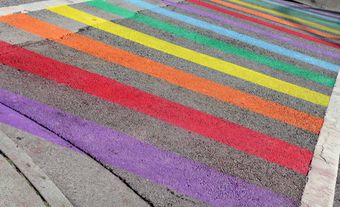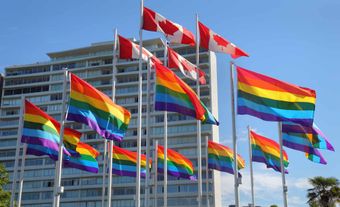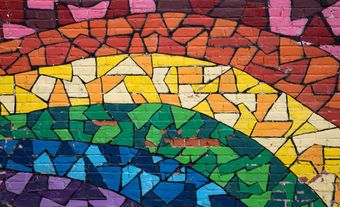On 15 July 1990, Montreal police raided a warehouse party known as Sex Garage, popular with the city’s LGBTQ community. Police declared the party illegal, herded people outside and then instigated an attack, injuring dozens and arresting several people. Members of the LGBTQ community mobilized in self-defence, holding several subsequent demonstrations. A sit-in the following day was violently interrupted by police in front of television cameras and reporters. These acts of violence shocked the public and galvanized LGBTQ resistance to police brutality and abuses of their civil rights. The event is considered an important turning point in Canadian LGBTQ history. (See Lesbian, Gay, Bisexual and Transgender Rights in Canada.)

© Linda Dawn Hammond / IndyFoto 1990
Background
Though today Montreal is a major destination for LGBTQ tourism, the city was not always as open and inclusive. Early recorded examples of homosexual relations from the mid-19th century were often written from a disparaging perspective. They were intended to shock audiences with lurid, often imagined descriptions.
Up until the 1960s, Montreal, like Quebec, was dominated by the Catholic Church and its socially conservative values. Exaggerated concerns over gay men meeting in public parks even led former Montreal Mayor Jean Drapeau to clear out much of Mount Royal’s underbrush in the mid-1950s. As a result of this, the city’s LGBTQ community was forced to hide from public view.
As Quebec and Canadian societies began to liberalize in the 1960s and 1970s, gays and lesbians began advocating for greater civil rights. (See Lesbian, Gay, Bisexual and Transgender Rights in Canada.) Despite these efforts, raids on gay and lesbian establishments by police continued well into the 1980s (see Toronto Bathhouse Raids, 1981). In Montreal, police morality squads regularly harassed the LGBTQ community’s nightclubs and gatherings. Police aggression in the late 1970s galvanized gay rights activists to petition the Quebec government to pass Bill 88. The law forbade discrimination based on sexual identity and preference. Quebec became the second jurisdiction in the world to do so.
Despite Bill 88 passing, attacks on members of the LGBTQ community continued, especially against gay men. Homophobic attacks even increased in Montreal in the late 1980s, particularly during the AIDS Crisis. On 19 March 1989, a gay rights activist named Joe Rose was murdered on a Montreal city bus.
The Raid
In the early morning hours of 15 July 1990, Montreal police raided the after-hours venue known as Sex Garage, located in a downtown Montreal loft. The event was popular with the city’s LGBTQ community. It is not clear what caused police to raid the location, since Montreal police offered several different explanations in the days that followed, including that there had been a noise complaint, that they suspected illegal liquor sales, and that the party’s promoter had requested assistance.
The police forced around four hundred people from the party and into the street. There they were met by Montreal police officers — without their nametags or badges — holding batons. Tensions were high, and it is alleged that the police made offensive gestures and taunted the partygoers with homophobic slurs. Police then attacked people at random. They also forced the crowd away from the venue and out onto Beaver Hall Hill — a wide street where even more police were waiting. Many people were beaten, some severely. Nine were arrested for a variety of charges, ranging from mischief to assaulting a police officer.
One of the people in attendance that night was Linda Dawn Hammond, who happened to have her camera and took several photos of police brutality. These iconic photos were published in Montreal’s two largest newspapers, La Presse and the Montreal Gazette, the next day.
Subsequent Protests
The first follow-up protest occurred on the evening of 15 July. Hundreds of demonstrators blocked the intersection of Amherst (now Atateken) and Saint-Catherine streets in Montreal’s Gay Village. Demonstrators negotiated with police officers and presented a list of demands, which were taken to then-Montreal police chief Alain St-Germain. The protesters demanded the release of the remaining patron still sitting in jail. They also demanded that a permanent LGBTQ representative position be added to the police minority relations committee. Moreover, the protestors wanted an investigation into the police brutality that occurred during and after the raid.
The next day, at around noon, about 250 people occupied the front of the police station where the officers responsible for the raid had been deployed to put more pressure on the police. The response was even more violent than the night of the raid as police dragged protesters by their hair and heads, put some in chokeholds and headlocks and aimed their batons at sensitive parts of the body, including genitals. Nearly 50 people were arrested and subsequently endured even more abuse while in police custody. Others were beaten so severely they were transported to hospital. Unlike the initial raid, this demonstration was extensively covered by local media, reported live and recorded by television cameras. The images of passive resistance on the part of the protesters contrasted sharply with the viciousness of the beatings and violence of the arrests by Montreal police. Police brutality became difficult to deny.
Aftermath
Although LGBTQ activism already existed prior to the raid, the police’s violent repression galvanized public sentiment in support of the city’s LGBTQ community. This encouraged even more protests in support of expanded civil rights and investigations into abuse of power and police brutality. (See Lesbian, Gay, Bisexual and Transgender Rights in Canada.)
The raid on Sex Garage occurred at around the same time as the Oka Crisis, which had begun four days earlier. In both cases, the police’s authority and legitimacy were undermined and challenged. As with the LGBTQ community at the time, Indigenous people felt that their rights were threatened by the state.

© Linda Dawn Hammond / IndyFoto 1990
In 1993, Montreal hosted its first pride parade, Divers/Cité. That same year, after a string of high-profile murders of LGBTQ people in the city, the Quebec government reversed course and authorized an investigation into violence against gays and lesbians. The Quebec Human Rights Commission’s landmark report, “From Illegality to Equality,” was released in 1994 and made 41 recommendations to expedite the expansion of civil rights and equality for the LGBTQ community. Progressive change continued over the course of the following ten years with the passage of Quebec Omnibus Bill 32 in 1999. The Bill extended benefits, pensions, and social services to same-sex couples. Same-sex marriage was legalized in Quebec in 2004 (followed by Canada in 2005).

 Share on Facebook
Share on Facebook Share on X
Share on X Share by Email
Share by Email Share on Google Classroom
Share on Google Classroom


